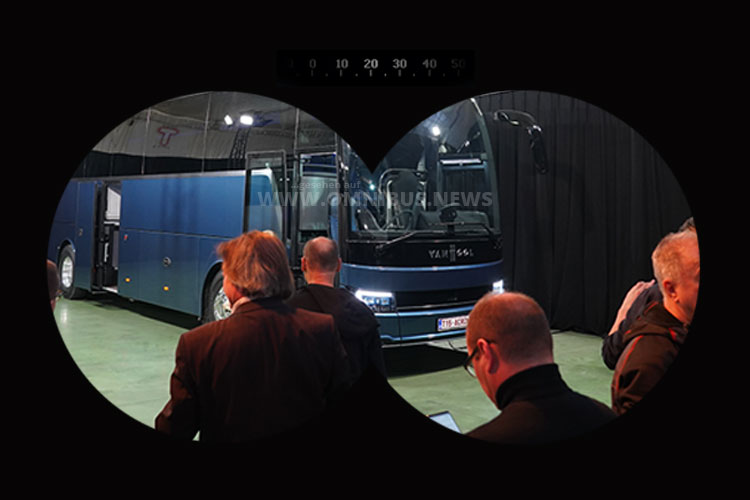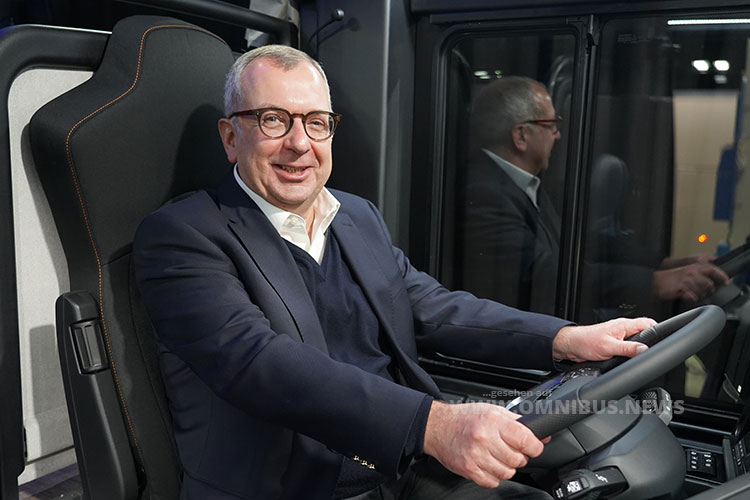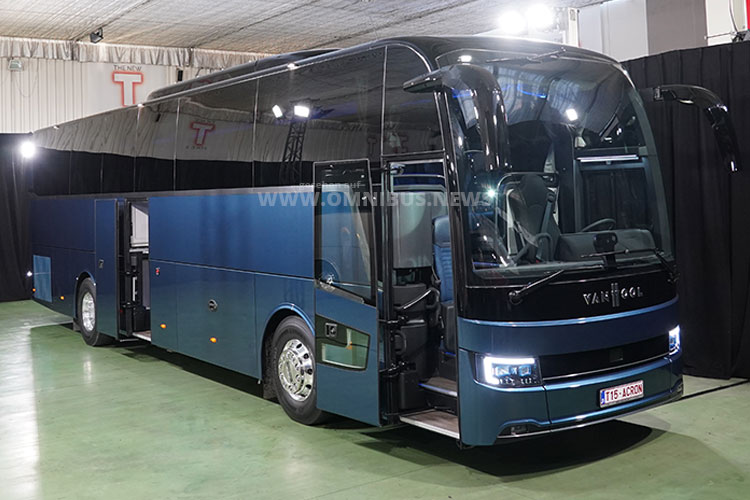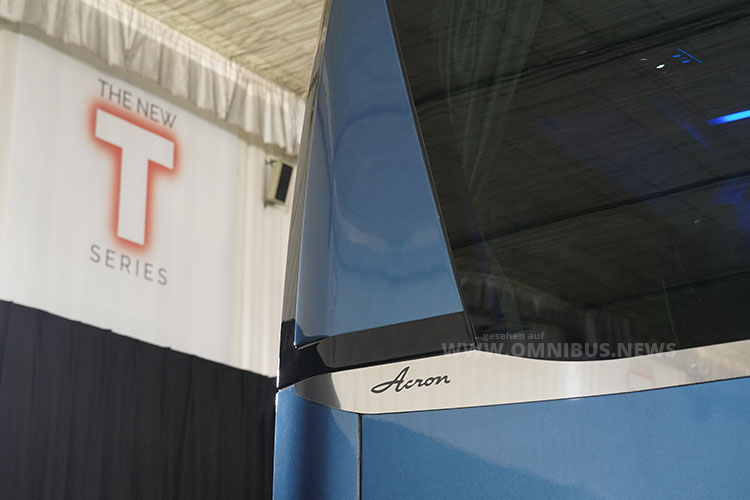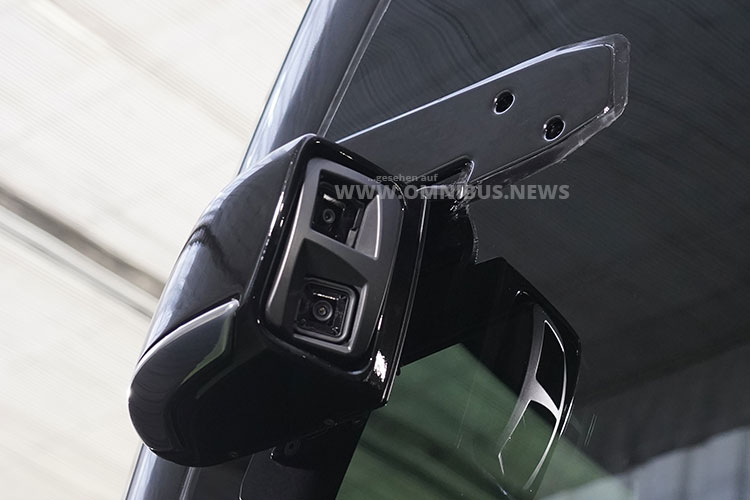
It’s T-time at Van Hool. Foto: omnibus.news

Filip Van Hool steered the belgian bus manufacturer confidently through the pandemic period. Photo: omnibus.news

The new T generation will be delivered from spring 2023. Foto: omnibus.news

The name of the series can be found in the chrome trim. Foto: omnibus.news

The camera of the mirror replacement system and the emergency mirror mount. Foto: Schreiber
T-time is not a British ritual, but a Belgian one: Van Hool is launching the new coach generation with the Alicron, Acron and Astron series. And it goes by the simple name of T. But it is not that simple. On the contrary, the vehicles now on display in Koningshooikt round off the top end of the portfolio alongside EX and TDX.
The first vehicles are to be delivered to customers from spring 2023. And they have already ordered heavily: 38 new coaches were ordered in the run-up to the premiere, and three orders were added after the show, as Filip Van Hool explains.
What Jan Van Hool and Benny Herdewyn designed was already convincing with the first coloured drawings – interested customers signed contracts immediately after taking a look at the design sketches, as the Belgians proudly say.
What characterises the new T-series is typical: for the next ten years, Van Hool will rely on the motto evolution instead of revolution. The familiar and the tried-and-tested have been further developed in style. A Van Hool is a coach that focuses on simple elegance instead of show effects.
A chrome strip on the side, discreetly marked with the name of the series, emphasises the horizontal lines that are so typical for us, notes Jan Van Hool. The front section was also decorated with chrome parts, very discreetly. Typical Van Hool, one line at the bottom of the front apron and another between the headlights – sometimes less is more.
Powerful and dynamic, the creative minds have given the new T generation a very distinctive rear end. Striking: almost all the edges have been cut, Van Hool calls it the wrap-around design.
When the airflow that touches the vehicle leaves at the rear, the integrated fairing fins and the spoiler at roof level guide the outflow in such a way that the turbulence is as low as possible. The whole rear design followed one function, the optimisation of aerodynamics, Benny Herdewyn told omnibus.news.
The most striking feature of the new T generation is the convex windscreen, as the designers explain in unison. They are on the way to streamlining, the shape and inclination will follow physical rules, also to minimise wind noise.
In the computer simulation, they had arrived at a very good value, which they now wanted to experience in the first driving tests on the road. To make this possible, the underside of the front of the new T-series buses was smoothed.
Newly designed exterior mirrors contribute to the improved drag coefficient, and those who opt for the mirror replacement system, which is already available as an option at the start, can further improve the air resistance of the bus.
The new T coaches are powered by Paccar-DAF, the 11 and 13 litre engines of the Euro 6 NG generation can be ordered with an output of 270 kW (367 hp) to 390 kW (530 hp), depending on the customer’s requirements. For the automated transmission, the customer can choose between products from ZF and Allison.
And an electric variant? Those who want to pay for it could already get it, in which case batteries from Proterra would be on board – Van Hool is delivering the first BEV double-decker to customers in America these days.
But what use is a BEV coach at present if there is no sufficient charging periphery throughout Europe? Scientists and analysts advising policymakers agree that public charging of BEV commercial vehicles, as in the passenger car sector, poses major challenges in terms of available locations and economic viability.
Van Hool is ready, a family-run company from Belgium already has it, the BEV coach. And it is already driving for customers, not in Belgium, not in Europe, but in America. Filip Van Hool is optimistic that the new coach with the classic drive concept will still be ordered by many customers.
The three buses presented at the Van Hool headquarters in Koningshookt were pre-production vehicles that were not yet perfect in all respects, as Filip Van Hool emphasized. Nevertheless, they showed themselves to be well finished and smart in many details.
And the inner values of the new T coaches? Van Hool has created something new there, too. A completely new interior atmosphere – for passengers and drivers alike. More about this in an upcoming report on omnibus.news. (VanHool/omnibus.news/Sr)
Further details? If you want to see what is inside the new T coaches, just klick here…
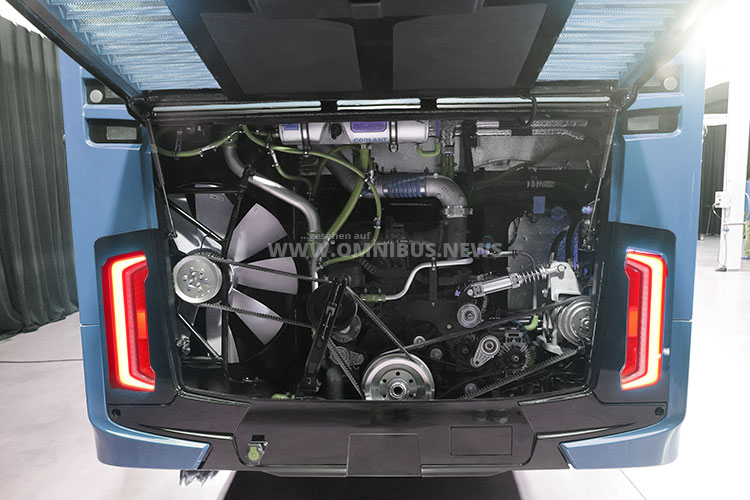
The new T-series is still equipped with a classic combustion engine by Paccar/DAF, but an electric drive will be introduced with the new base from 2024. Foto: Schreiber
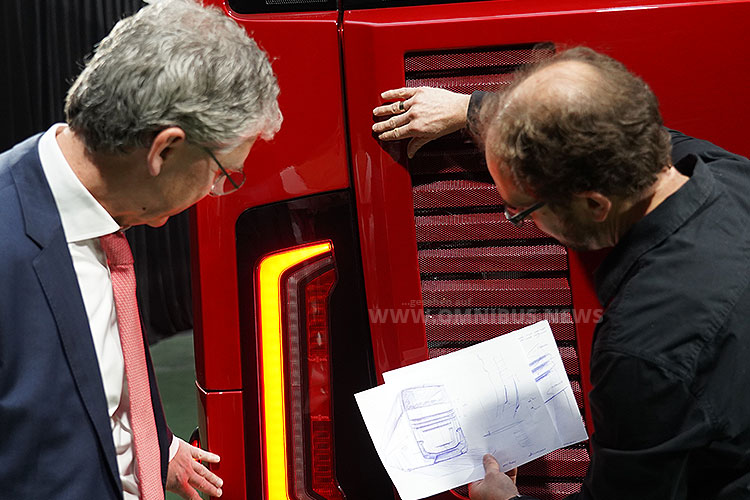
Jan Van Hool and Benny Herdewyn with the first sketch and the finished vehicle. Foto: Schreiber
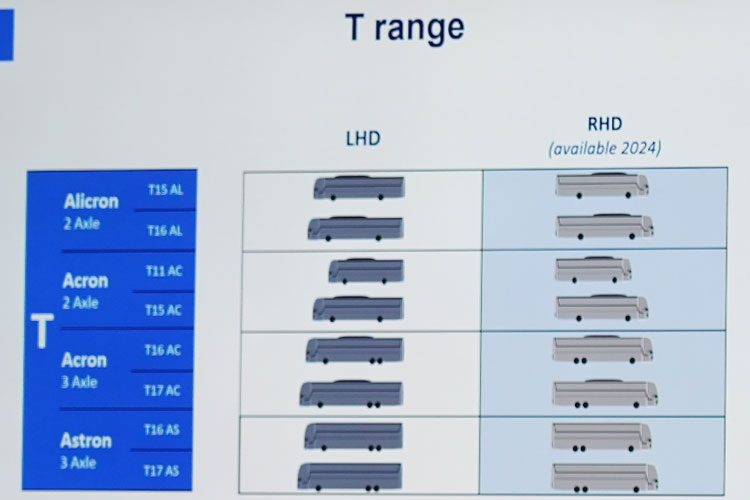
At the launch of the new T series, the choice is still limited, the double-decker will follow in 2024. Foto: Schreiber
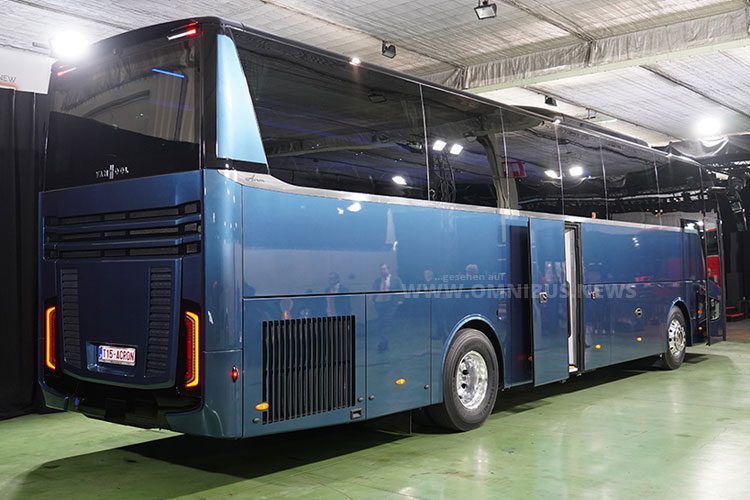
At the launch of the new T series, the choice is still limited, the double-decker will follow in 2024. Foto: Schreiber
Die T-time ist kein britisches Ritual, sondern ein belgisches: Mit den Baureihen Alicron, Acron und Astron startet Van Hool die neue Reisebus-Generation. Und die hört ganz schlicht und einfach auf den Namen T. Wobei, so ganz einfach ist sie gar nicht. Ganz im Gegenteil, die jetzt in Koningshooikt gezeigten Fahrzeuge runden das Portfolio neben EX und TDX nach oben hin ab.
Ab Frühjahr 2023 sollen erste Fahrzeuge an Kunden ausgeliefert werden. Und die haben schon kräftig geordert: 38 neue Reisebusse wurden im Vorfeld der Premiere bestellt, nach der Show kamen drei Bestellungen hinzu, wie Filip Van Hool erklärt.
Was Jan Van Hool und Benny Herdewyn entworfen haben, hat schon mit ersten farbigen Zeichnungen überzeugt – interessierte Kunden hätten nach einem Blick auf die Designentwürfe sofort Verträge unterschrieben, wie die Belgier voller Stolz sagen.
Das, was die neue T-Reihe ausmacht, ist typisch: Für die nächsten zehn Jahre setzt Van Hool auf das Motto Evolution statt Revolution. Bekanntes und Bewährtes wurden stilsicher weiterentwickelt. Ein Van Hool ist ein Reisebus, der auf schlichte Eleganz statt Show-Effekte setzt.
Eine Chromleiste an der Seite, dezent mit dem Namen der Baureihe versehen, unterstreiche die für uns die so typische horizontale Linienführung, merkt Jan Van Hool an. Auch die Frontpartie wurde mit Chromteilen geschmückt, ganz dezent. Typisch Van Hool, eine Linie unten an der Bugschürze und eine weitere zwischen den Scheinwerfern – weniger ist manchmal mehr.
Kraftvoll und dynamisch, ein ganz markantes Heck haben die kreativen Köpfe der neuen T-Generation mit auf den Weg gegeben. Auffällig: Die Kanten wurden nahezu allesamt angeschnitten, Van Hool nennt es das Wrap-Around-Design.
Wenn der Fahrtwind, der das Fahrzeug berührt, am Heck verlässt, führen die integrierten Verkleidungsfinnen und der Spoiler auf Dachhöhe die Abströmung so, dass die Turbolenzen so gering wie möglich sind. Das ganze Heckdesign sei einer Funktion gefolgt, der Optimierung der Aerodynamik, so Benny Herdewyn gegenüber omnibus.news.
Das Auffälligste der neuen T-Generation sei die konvexe Windschutzscheibe, wie die bei den Designer unisono erklären. Man sei auf dem Weg zur Stromlinienform, Form und Neigung würden durchaus physikalischen Regeln, auch zur Minimierung der Fahrtwindgeräusche, folgen.
In der Computer-Simulation sei man zu einem sehr guten Wert gekommen, dieser wolle man nun bei ersten Fahrversuchen auf der Straße auch erfahren. Damit das klappt, wurde an der Vorderseite der neuen Omnibusse der T-Serie jeweils noch die Unterseite geglättet.
Neu gestaltete Außenspiegel leisten ihren Teil des verbesserten cW-Wertes, wer auf das Spiegelersatzsystem, das es zum Start auch schon als Option gibt, setzt, kann den Luftwiderstand des Omnibusses weiter verbessern.
Angetrieben werden die neuen T-Reisebusse von Paccar-DAF bestückt, die 11 und 13 Liter Motoren der Euro 6 NG-Generation sind je nach Kundenwunsch mit einer Leistung von 270 kW (367 PS) bis 390 kW (530 PS) bestellbar. Beim automatisierten Getriebe kann der Kunde zwischen Produkten von ZF und Allison wählen.
Und eine elektrische Variante? Wer diese bezahlen will, könnte sie auch schon bekommen, dann wären Batterien von Proterra an Bord – für Kunden in Amerika liefert Van Hool diese Tage den ersten BEV-Doppeldecker aus.
Doch was nutzt aktuell ein BEV-Reisebus, wenn es europaweit keine ausreichende Ladeperipherie gibt? Wissenschaftler und Analysten, die die Politik beraten, sind sich einig, dass das öffentliche Laden von BEV-Nutzfahrzeugen wie auch im Pkw-Bereich große Herausforderungen hinsichtlich der verfügbaren Standorte und der Wirtschaftlichkeit mit sich bringe.
Van Hool ist bereit, ein familiengeführtes Unternehmen aus Belgien hat ihn schon, den BEV-Reisebus. Und er fährt auch schon bei Kunden, nicht in Belgien, nicht in Europa, sondern in Amerika. Filip Van Hool gibt sich optimistisch, dass der neue Reisebus mit klassischem Antriebskonzept noch von vielen Kunden bestellt werden wird.
Die in Koningshookt am Van Hool-Stammsitz vorgestellten drei Busse waren Vorserienfahrzeuge, die noch nicht in allen Punkten perfekt seien, wie Filip Van Hool betonte. Trotzdem zeigten sie sich gut verarbeitet und in vielen Details pfiffig.
Und die inneren Werte der neuen T-Reisebusse? Auch da hat Van Hool etwas Neues geschaffen. Eine völlig neue Innenraumatmosphäre – für Fahrgäste wie Fahrer begeistert. Dazu mehr in einer der nächsten Meldungen auf omnibus.news. (VanHool/omnibus.news/Sr)

